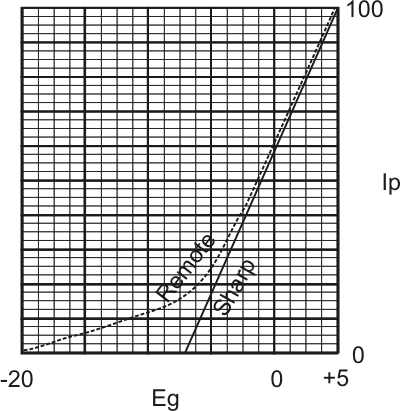New 811A tubes have inconsistent cut-off characteristics. This is similar to the Svetlana 572B behavior differences in Yaesu amplifiers, where tubes oscillate on standby. People blame this on higher tube mu or transconductance, but the problem really centers around cutoff bias characteristics. Some off-shore tubes behave differently than older USA transmitting tubes behaved. Making things worse, some off-shore transmitting tubes behave differently from batch-to-batch. These tubes act as if they are lower mu for cutoff, very much like a semi-remote control grid used in tubes designed for AGC controlled stages.
Amplification Factor
Amplification factor is represented by the Greek letter µ (also called "mu"). Grid-to-cathode voltage controls cathode-to-anode current. For example, a 10-volt change in grid voltage might affect anode current as much as a 100 volt change in anode voltage. Amplification factor, or mu or µ, tells us how much more a grid voltage change affects anode current than an anode voltage change affects anode current. For example, if a 1-volt grid change, from -20 to -21 volts, affects anode current the same as a 20-volt anode voltage change, say from 800 to 820 volts, µ (mu) is 20/1 = 20. We do this over a small range of anode voltages.
We can also say mu is ∆Ep / ∆Eg for ∆Ip = 0.
We would determine µ by setting anode and grid voltages and looking at current, adjusting anode-to-cathode voltage a certain small amount while carefully watching the change in anode current, and adjusting grid voltage to maintain the original anode current. This would tell us delta Eg for a certain delta Ep.
This is not exactly the same as stage amplification or gain, it is amplification factor. Amplification factor (or µ) can, and usually does, vary through different operating voltage ranges. Mu or µ is most consistent over wide operating ranges in tubes like beam power tubes, or pentodes, and least consistent in triodes. This is not the same as gain. Gain will be some amount less than µ.
Semi-remote and Remote Cutoff
Semi-remote grid behavior is also like having a significantly variable amplification factor, or variable mu, as we change grid voltage. This is accomplished by winding the grid with a variable wire pitch, or by allowing electrons to "leak around" areas of high electrostatic charge in the grid. Sometimes this happens in unintentional cases out through the grid's open ends.
In a variable-mu tube, the cathode has a path to anode through areas where the grid does not have the same control.
As bias moves toward cutoff, denser electric field areas of the grid cut completely off. Only the more open areas with less control determine current. The influence of the grid becomes less as bias increases.

Remote cut-off or variable mu is intentionally used in AGC controlled (automatic gain control) stages. Variable mu increases the useful gain range of the stage, allowing smooth AGC control without serious distortion.